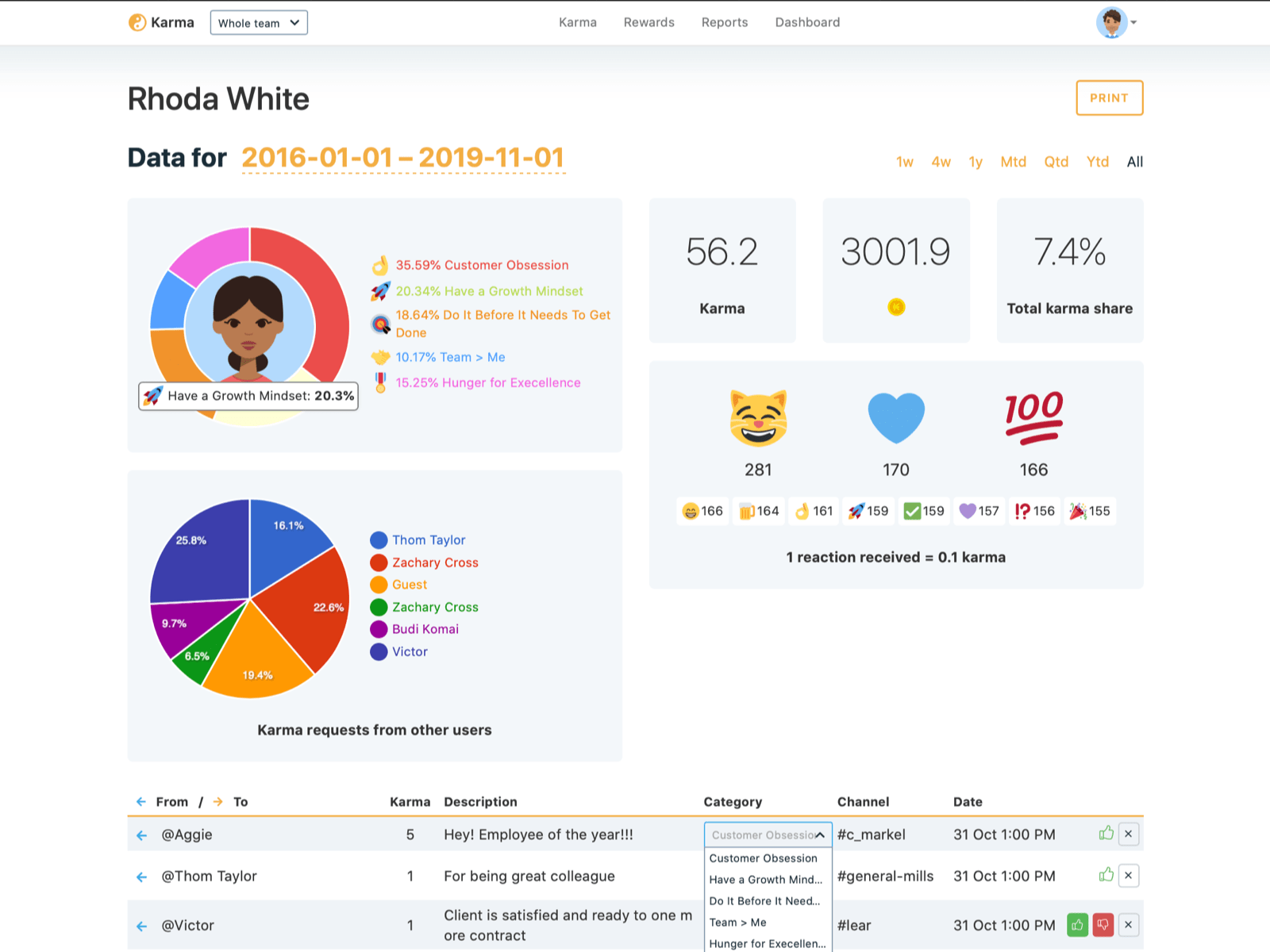Presenteeism; the grown-up equivalent of staring off into space during class and imagining you are superman. Except now instead of just annoying Ms.Jones, employees are costing their employers thousands of dollars a year. Managers often focus on how many days employees take off from work, which averages 4 days per year. Yet, employees admit to not being productive on an average of 57.5 days per year. That is a whole lot of money going towards clock-watching. It is also an untapped potential of 12 additional work weeks each year for companies who are ready to increase employee engagement.
3 months is a lot of extra time for fixing bugs features, improving response times, developing new products, and on and on. Increasing employee engagement through rewards and recognition is an easy change with big returns.
What is employee engagement?
Employee engagement is the passion and enthusiasm employees have for their role, team, and the company they work for. We understand the importance of engagement clearly when referring to customers, yet statistics show that many businesses fail to apply that knowledge to an equally important group; the people building the company. If we look after the people who look after the business, that is going to reflect in increased productivity and more positive interactions with users.
There are a large number of reasons why employees struggle with productivity. Feeling sick, stressed, bored, or can’t get Baby Shark out of their head to name a few. Most of the time, however, it is because they just are not feeling a connection to the job and their coworkers. It could be a lack of recognition, workplace drama, no clarity about their tasks or the direction of their role.
A fast yet extremely effective solution for building stronger bonds between peers is through continuous micro-feedback.

How can micro-feedback help employee engagement?
Micro-feedback is an amazing tool for making positive, measurable changes quickly. It refers to collecting and providing feedback and reactions immediately in response to a task or behaviour.
The traditional method of dragging employees into the office once a year for a stressful performance review is absolutely not the answer for reducing presenteeism. Providing positive recognition or addressing concerns once or twice a year provides very little opportunity for growth - especially measurable growth - and contributes nothing to nurturing positive connections between peers.
The clarity and motivation that comes from continuous micro-feedback, however, helps employees identify what is expected, when they are on the right track, and reinforces great work. Peer-to-peer micro-feedback is especially beneficial for creating a sense of belonging and responsibility within teams.
Tips for providing micro-feedback
Offering feedback doesn’t come easy for everyone. A poll by Interact found that 37% of managers felt uncomfortable giving feedback, and 69% were uncomfortable communicating at all with their employees. In many teams, feedback between coworkers is rare or non-existent.
Suddenly makes the lack of connection between employees and their roles a little more understandable, doesn’t it?
Don’t forget the good stuff

It is not uncommon to equate feedback with negativity. Though it can be easy to be a critique, only focusing on what needs to be corrected can cause confusion, frustration, and resentment. It is just as important - arguably more important - for employees to receive positive recognition from their coworkers and managers. It is easy to understand why someone might not feel warm fuzzies towards their job if they feel like they are under attack.
The behaviours that trigger positive feedback are more likely to be repeated. Besides, it just feels plain good when your work is appreciated.
Use micro-feedback as a way to build and reinforce human connections in the workplace. Whether you are a manager or coworker, make sure good work never goes unnoticed.
Clarity is key
According to research conducted by Gallup, employees are 2.5 times more likely to be engaged on the job when they are held accountable for their performance. Why? It means they are completely clear about their role in the company and the desired outcome from their work. Clear goal-setting offers direction and aids in showing employees how they contribute to the success of the business. Use micro-feedback to provide recognition when a team member is hitting targets.
Use micro-feedback to aid employee training
Training a team member on new tasks can be overwhelming for everyone, especially the person being trained. Usually, it is a whole lot of information to remember at one time and it is not always easy to know what is right and what is wrong. Micro-feedback is very well suited for gently guiding people towards consistently accurate work by addressing small things individually and allowing those lessons ample time to be absorbed.
Integrating Karma for consistent micro-feedback
Providing continuous feedback may sound like a hassle, but it doesn’t have to be. Karma to the rescue!

Karma integrates with Slack or MS Teams and can be set-up in minutes. It builds functionality into programs already being used by your team and with no training required. Users just type Karma + @name + reason for recognition.
Karma @Sally I loved how you responded to that customer!
Any time a team member is recognized, a Karma point is rewarded which can be redeemed for rewards and viewed in the leaderboard.
“Not only has the frequency of recognition increased, but team members have reported an increase in happiness and connection after the implementation of this tool. Managers have also been provided with an opportunity to learn about helpful behavior among team members that they may not have otherwise heard about through the openness and transparency this tool provides.” - Karoline S.
Using Karma for micro-feedback is a fun, positive way for coworkers to give each other the recognition and guidance they need to stay engaged and excited about the work they are doing.
Relying on occasional team events to strengthen bonds and drive engagement simply isn’t enough for building an enthusiastic workforce. This is especially true since COVID-19 has kept people away from the office and working on their own with a lack of peer interaction (however, if you’re looking for additional ways to combat this, check out our blog post on working from home engagement tools).
The easy addition of micro-feedback offers employees the daily recognition and positive reinforcement they deserve, which creates a happier and more focused team.
If you’re looking to add instant peer-to-peer feedback for positive reinforcement, check out Karma.


 Continuous and anonymous feedback in the workplace for a happier team
Continuous and anonymous feedback in the workplace for a happier team